My name is Michelle, and I’m a Paula’s Choice tragic.
I first got into skincare around 2009. Back then we didn’t have all the brands we have now – and more importantly, we didn’t have all the skincare information we have now. Paula Begoun was one of the few lone voices in the internet landscape talking about the science behind skincare and busting skincare myths. Paula’s Choice (and everything else Paula’s done) is actually a really big reason why science-based skincare is so normalised now.
So I was a bit “senpai noticed me!” when Paula’s Choice approached me to do a sponsored video. I know Paula’s very busy and probably had nothing to do with it, but we don’t know for sure, so we’re going to assume Paula picked me and no one can prove that’s not true.
Here are my top picks from the Paula’s Choice range – the video is here, keep scrolling for the written version!
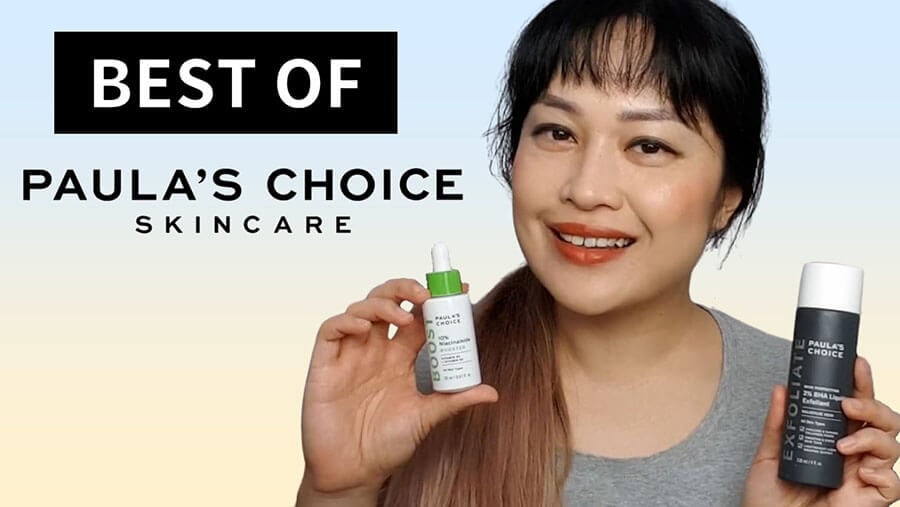
My Paula’s Choice Favourites
Paula’s Choice have a lot of products. I barely feel like I’ve touched the range, so it’s quite likely I’ve missed a bunch of great products (let me know in the comments if there are other products I need to try!).
This is one of the few brands where I really think any skin type could get their entire skincare routine from their range. They had around 11 regular cleansers and 20 moisturisers without SPF listed on their US site when I last checked – it’s a lot of products!
Out of the products I’ve tried, these are my favourites.
2% BHA Liquid Exfoliant
Those of you who have followed me for a while knew I’d be talking about Paula’s Choice 2% BHA Liquid Exfoliant!
This was the first product from Paula’s Choice when I got into skincare in 2009, and it was my first “real” skincare product that I bought after lots of reading tons of reviews online.
Paula’s Choice is really well known for popularising chemical exfoliants in skincare. Chemical exfoliants in skincare are alpha, beta and poly hydroxy acids. These ingredients help your dead skin cells shed evenly. While this should happen naturally (the natural process is usually called desquamation), sometimes this process doesn’t work as well as we’d like, leading to clogged pores, rough and dull skin and more pronounced fine lines and wrinkles. Exfoliants can give it a bit of a nudge.
These days, it seems like every brand has a chemical exfoliant, but back then there were about 8 on the market, and 4 of them were from Paula’s Choice.
They haven’t changed the formula of the 2% BHA Liquid much, but it’s still somehow really stood its own after more than a decade, and remains the best formula I’ve tried. As a skincare content creator, I’ve tried a lot of skincare products, and for most product categories there’s a few different options I end up enjoying and using regularly. But for salicylic acid, this is the one that’s on its own level for me, and I’ve heard a lot of other people say this as well. It’s definitely the longest skincare relationship I’ve had!
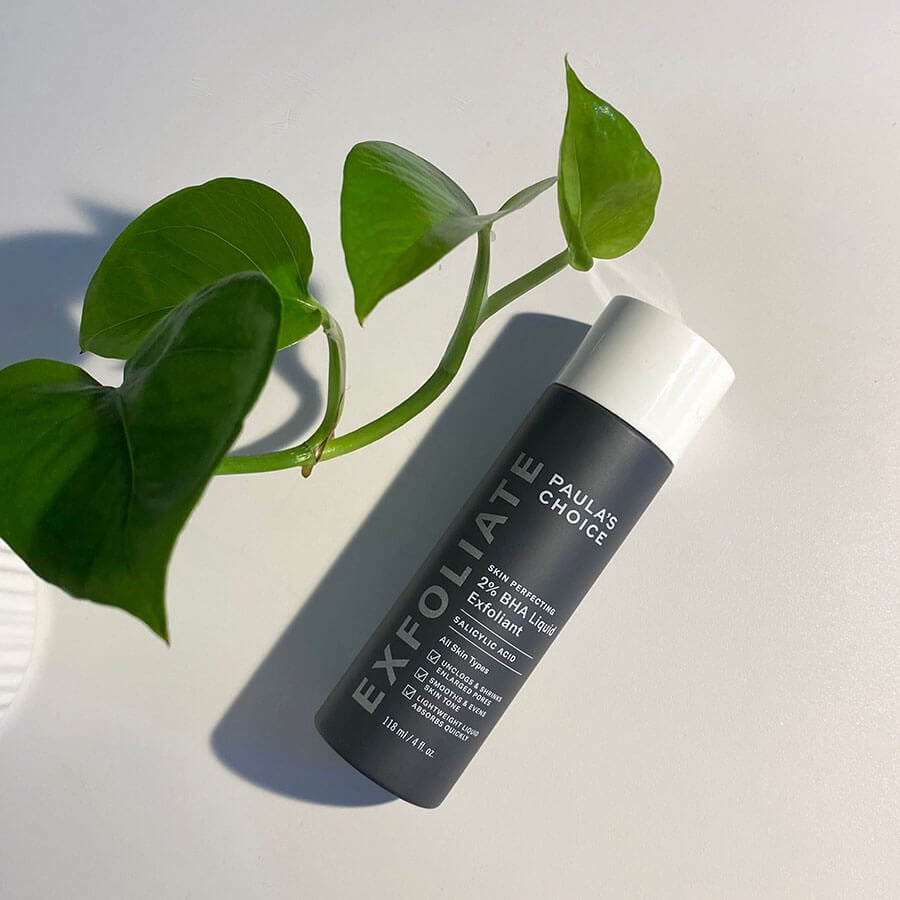
Paula’s Choice has a philosophy where they always try to include other supporting ingredients in their products. This is one of the simpler formulas, but it still has humectants in the base to help keep skin hydrated, and green tea to reduce irritation.
Salicylic acid is a bit drying, and this product can feel a little tight when you first use it until your skin adjusts. I’ve found that following up with a hydrating toner or moisturiser helps reduce the discomfort.
I’ve really come to depend on the 2% BHA Liquid for keeping my pores clear and preventing the gunk in them from going dark. I apply this with my fingers, focusing on my T-zone, a few nights each week. I’ve also used it in the morning before and it worked well, but I moved it back to night time to keep my morning routine as simple as possible.
As well as this liquid version (which comes out as a very runny liquid), there’s also a lotion version, but I’ve been so happy with the liquid version I’ve never really had the urge to try it.
If you’re already a fan of the 2% BHA Liquid, you might also like the Clear Acne Body Spray – it’s a very similar product but in a spray form.
I really like this for reaching my back, and conveniently the spray even sprays upside down. I would avoid spraying this near your face – exfoliating your lungs is probably not a great idea.
2% BHA Liquid Exfoliant Ingredients: Water, Methylpropanediol, Butylene Glycol, Salicylic Acid, Polysorbate 20, Camellia Oleifera, Sodium Hydroxide, Tetrasodium EDTA
Clear Acne Body Spray Ingredients: Water, Dipropylene Glycol, Butylene Glycol, Polysorbate 20, Pentylene Glycol, Salicylic Acid, Panthenol, Sodium Hyaluronate, Dipotassium Glycyrrhizate, Glycyrrhiza Glabra (Licorice) Root Extract, Berberis Vulgaris Root Extract , Lauric Acid, Allantoin, Glycerin, PEG/PPG-17/6 Copolymer, Methyl Gluceth-20, Glycereth-26, Sodium Hydroxide, Sodium Metabisulfite, Disodium EDTA, Potassium Sorbate
Related post: Debunking Exfoliation Myths (with video)
10% Niacinamide Booster
Paula’s Choice 10% Niacinamide Booster was the product that converted me to niacinamide.
Niacinamide is a form of vitamin B3. It’s is a really great all-round ingredient, and it’s become incredibly popular in the last couple of years.
Niacinamide helps with brightening and it can reduce the appearance of brown patches like a lot of other ingredients, but it’s also been tested on red blotchiness and yellow sallowness as well. It also smooths out skin texture and fine lines, and one of the very few ingredients that might be able to make pores look smaller.
I think the main reason niacinamide has taken off is that it’s an active, but it isn’t very irritating at effective levels (unless your skin is specifically sensitive to it). Most of the other actives with lots of good evidence behind them, like retinoids and exfoliating acids, are a bit irritating even if your skin’s become used to them. So niacinamide is like a little working holiday for your skin.
Confession time: I wasn’t cool enough to like niacinamide before it became really popular. I knew about all the data backing up its effectiveness, but after trying a couple of products with niacinamide I didn’t really see much of a difference, so I gave up pretty quickly.
But Paula’s Choice 10% Niacinamide Booster is the product that actually made a big difference on my skin and converted me to the wonders of niacinamide, and I’ve seen some other people agree that this is the product that works the best for their skin. It does seem that there’s quite a bit of variation with the results you get from different niacinamide product formulas, even with the same percentage of niacinamide.
There are also some other great ingredients in the formula that could be making a big difference. This product also has ascorbyl glucoside in it, which is one of my favourite vitamin C derivatives. Additionally, there are a whole bunch of other supportive ingredients and antioxidants in this that add to the soothing effect, including allantoin and licorice extract. There’s a huge list of other antioxidants in this as well (Paula’s Choice really love their antioxidants).
The texture of this product is really watery and light, making it very easy to incorporate into a skincare routine. It layers nicely under every product I’ve tried.
You can use this morning or night. I tend to include it every few nights during my regular routine. When my skin is really irritated, I’ll sometimes use this on its own or paired with a plain moisturiser for a few nights.
Paula’s Choice also have a 20% niacinamide product which a lot of people like, if you want to use an even higher concentration of niacinamide.
Related post: What Is Niacinamide and What Does It Do in Skincare?
10% Niacinamide Booster Ingredients: Water, Niacinamide, Acetyl Glucosamine, Ascorbyl Glucoside, Butylene Glycol, Phospholipids, Sodium Hyaluronate, Allantoin, Boerhavia Diffusa Root Extract, Glycerin, Dipotassium Glycyrrhizate, Glycyrrhiza Glabra (Licorice) Root Extract, Ubiquinone, Epigallocatechin Gallate, Beta-Glucan, Panthenol, Carnosine, Genistein, Citric Acid, Sodium Citrate, Sodium Hydroxide, Xanthan Gum, Disodium EDTA, Ethylhexylglycerin, Phenoxyethanol
Clinical 0.3% Retinol and 2% Bakuchiol Treatment
Paula’s Choice Clinical 0.3% Retinol and 2% Bakuchiol Treatment is one of my favourite retinol products. Retinol is a form of vitamin A that’s considered a gold standard anti-aging skincare ingredient.
When I first started on retinol, I made the mistake of using a big blob of the Paula’s Choice 1% retinol a few nights in a row. Unfortunately, 1% is a very high concentration for retinol. I thought my skin could handle it because I was used to using 20% chemical exfoliants with no big issues. But retinol is a whole different game!
I think the really sneaky thing about retinoid irritation is that it only pops up about a day and a half later. With chemical exfoliants, you can usually tell if you’ve gone overboard immediately after you’ve applied it, based on how much it’s stinging. You have a chance to wash it off and treat your face like a baby the next night. But with retinoids, it’ll often still be fine the next night. So if you’re a chump (like me), you’ll think your skin is doing fine, so you use even more the next night. Then the morning after, you wake up with a desiccated face.

My face was red and peeling, with all of the classic retinoid irritation signs for about a week. Plus, I caught a cold around the same time so I was blowing my nose a lot and it was just awful.
That really taught me a valuable lesson, which is why I started tretinoin super slowly.
Related post: My Routine for Starting on Tretinoin (Retin-A) Cream (with video)
Paula’s Choice 1% Retinol is a fantastic product if you want a really strong retinoid product. It’s one of the best sellers from Paula’s Choice. But I think I’ve thoroughly demonstrated I am not responsible enough for that sort of power. And even now that my skin’s adjusted to retinoids, I find that sometimes I’ll apply too much and 36 hours later I’ll have slightly peely skin, which is extremely annoying if I need to apply makeup on top.
So I actually really like gentler retinol products like this treatment, which has 0.3% retinol. If I’m really tired and zone out during my skincare routine and apply a bit too much, it’s not such a big deal.
And I like it even more when there are other ingredients in there with the retinol. Less steps is always a win for me, and I love not having to think about layering and ordering, and whether you’re using too many things and risking irritation. It just cuts out a lot of variables.
As well as retinol, this has 2% bakuchiol. Bakuchiol is a plant ingredient that’s been marketed as a “natural alternative to retinol”, which I don’t really like. The argument is that it also helps with reducing the appearance of wrinkles and hyperpigmentation like vitamin A. But it isn’t a retinoid, doesn’t work the same way as vitamin A, and doesn’t have anywhere the same level of evidence as retinol. But it’s still a pretty promising ingredient, and I really like the way Paula’s Choice markets this: bakuchiol is a supplement to retinol, it’s not meant to be used instead of retinol.
Related post: Bakuchiol: Better Than Retinol?
This product also includes peptides and a whole bunch of skin soothing ingredients and antioxidants in classic Paula’s Choice style.
The texture is that of a nice lightish lotion. I found it gentle and non-irritating, and the base is thick enough to work as a moisturiser for my oily skin. I just love this as a one step, foolproof product for when I’m tired (which is a lot of the time now).
0.3% Retinol and 2% Bakuchiol Treatment Ingredients: Water, Dimethicone, Pentaerythrityl Tetraisostearate, Isononyl Isononanoate, Butylene Glycol, Bakuchiol, Arachidyl Alcohol, Glyceryl Polymethacrylate, Dimethicone Crosspolymer, Behenyl Alcohol, Glycerin, PEG-75 Shea Butter Glycerides, Glyceryl Stearate, C12-15 Alkyl Benzoate, Polysorbate 20, Tetrahexyldecyl Ascorbate, Retinol, Ceramide NG, Palmitoyl Tetrapeptide-7, Palmitoyl Hexapeptide-12, Sodium Hyaluronate, Dipotassium Glycyrrhizate, Glycyrrhiza Glabra (Licorice) Root Extract, Avena Sativa (Oat) Kernel Extract, Arctium Lappa, Salix Alba Extract, Glycine Soja Sterols, Lecithin, Allantoin, Tocopheryl Acetate, Hydrolyzed Soy Protein, Palmitoyl Tripeptide-1, Sodium Hydroxide, Tribehenin, Caprylyl Glycol, Dipeptide-2, Polygonum Cuspidatum Root Extract, PEG-10 Phytosterol, PEG-8, Magnesium Aluminum Silicate, Arachidyl Glucoside, Pentylene Glycol, Sodium Acrylates Copolymer, Hydroxyethyl Acrylate/Sodium Acryloyldimethyl Taurate Copolymer, Cetearyl Alcohol, Coco-Glucoside, Hesperidin Methyl Chalcone, N-Hydroxysuccinimide, Disodium EDTA, Phenoxyethanol, Benzoic Acid, Ethylhexylglycerin
Super-Light Daily Wrinkle Defense SPF 30
Paula’s Choice Super-Light Daily Wrinkle Defense SPF 30 is a tinted base cosmetic SPF in Australia, but it’s sold as a proper sunscreen in the US and Europe. This is the nicest zinc oxide product I’ve ever tried.
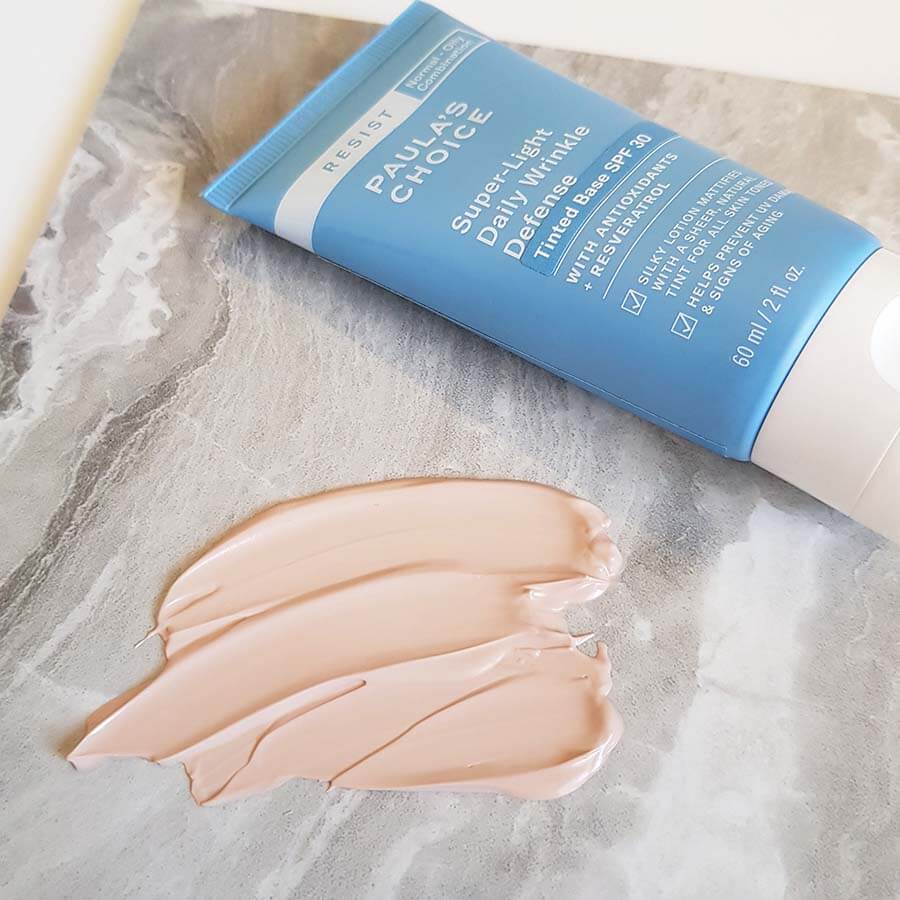
I’ve talked about why zinc oxide is an annoying sunscreen ingredient before – zinc oxide doesn’t absorb UV very well, so you need to put a lot of it into a product to get a decent SPF. But zinc oxide is an inorganic mineral, which means it’s basically like powdered clay or ground up rock.
Related post: Zinc Sunscreens Don’t Work Better: Every Myth Busted (with video)
This product has 13% zinc oxide, so between 1/7 and 1/8 of this tube is powdered zinc oxide and the rest is a thickish, oily base to try to keep the powder spread out. So it’s a real challenge to make that feel nice on your skin! And if a skincare product doesn’t feel nice, you don’t end up applying as much, which means lower sun protection because SPF scales with the amount you apply.
Related post: Video: What Does SPF Mean? Is High SPF Sunscreen Better?
This is only SPF 30 (which isn’t that low, but I feel like SPF 50 is standard now), so it doesn’t need as much zinc oxide as a lot of higher SPF sunscreens, which often use 20-25%. But for me, the higher SPF isn’t worth the heavy feeling on my face. For situations where I need higher SPF, I use chemical or combination sunscreens.
The other big issue with zinc oxide is white cast on darker skin. Even though my skin isn’t that dark, I still get white cast with a lot of zinc oxide sunscreens.
Super Light Wrinkle Defense is lightly tinted to hide the white cast and it works really well on my skin. It does take a minute or so to settle, so I was a bit worried when I first applied it! But after a few minutes, it’s pretty unnoticeable on my skin (I’m wearing it on the right side of this photo).
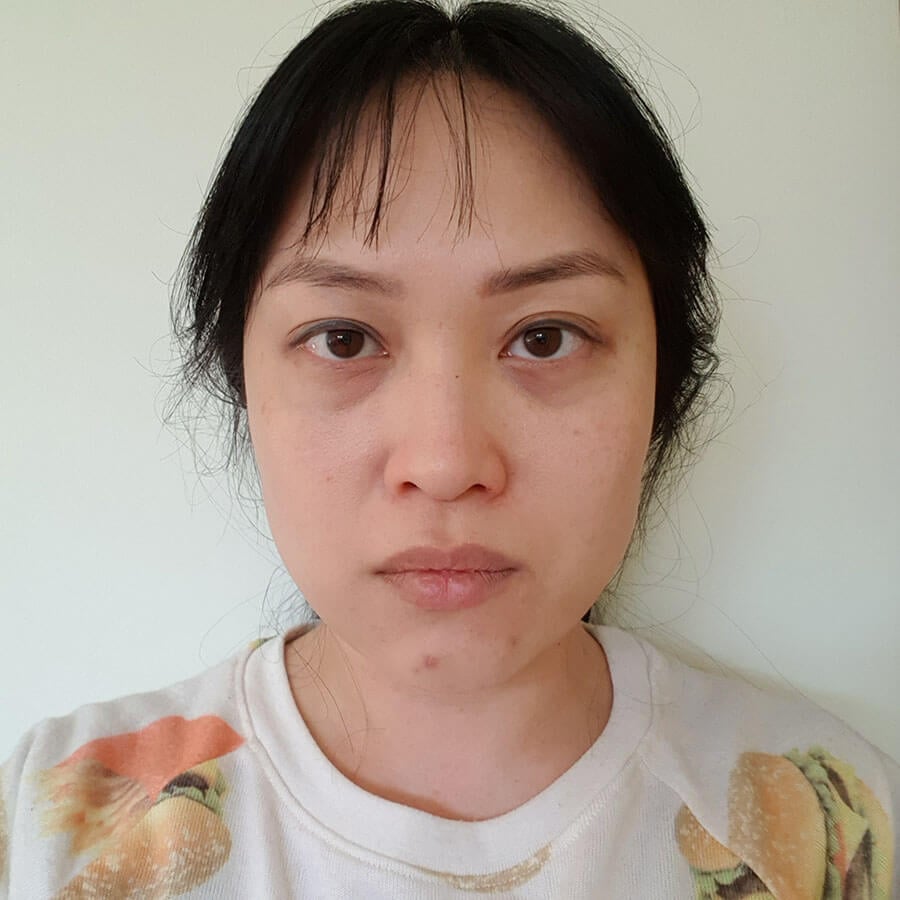
I’ve heard it doesn’t blend that well for darker skin, but for me, this is the zinc oxide-only product with the least compromises.
Super Light Wrinkle Defense Ingredients: Water, Cyclopentasiloxane, Zinc Oxide, PEG-12 Dimethicone, PEG/PPG-18/18 Dimethicone, Lauroyl Lysine, Sodium Chloride, Trihydroxystearin, Dimethicone Crosspolymer, Resveratrol, Quercetin, Epigallocatechin Gallate, Tocopheryl Acetate, Tetrahexyldecyl Ascorbate, Adenosine, Bisabolol, Salix Nigra (Willow) Bark Extract, Punica Granatum Extract, Haematococcus Pluvialis Extract, Hydrolyzed Corn Starch, Polysorbate 80, Hydrated Silica, Triethoxycaprylylsilane, C12-15 Alkyl Benzoate, Isopropyl Titanium Triisostearate, Caprylyl Glycol, Hexylene Glycol, Ethylhexylglycerin, Iron Oxides, Phenoxyethanol
Two more products I wanted to shout out:
C25 Super Booster
Paula’s Choice C25 Super Booster is a vitamin C product that has fine particles of ascorbic acid in a silicone base.
Vitamin C is an antioxidant that’s great for brightening skin and evening out your skin tone. Ascorbic acid is the form of vitamin C with the best evidence but it’s pretty annoying, as I’ve discussed before. It’s really unstable but when it’s in a silicone base like in this product, it goes off a lot slower. The silicone wraps around the ascorbic acid and protects it from oxygen and water, which accelerate its breakdown.
I like to mix this with another product because I still find it a bit strong on its own. I also don’t really like the feel of silicone skincare products (everyone else says silicones are cosmetically elegant and silky, so I’m in the minority). I usually mix a little blob of this with 2% BHA Liquid, but you can mix it into other serums or moisturisers too.

I’ve put this in this extra section because this product is quite strong, and not suitable for a lot of people. If you don’t use a gentler ascorbic acid product already, I wouldn’t recommend this – it’s probably going to irritate your skin. For a vitamin C beginner, I’d suggest their C15 Super Booster instead which is a more standard water based ascorbic acid product. But since my skin loves vitamin C, this is perfect because I take forever to finish products and this goes off super slowly!
C25 Super Booster Ingredients: Cyclopentasiloxane, Ascorbic Acid, Ethylhexyl Hydroxystearate , Polysilicone-11, Dimethicone, Polymethylsilsesquioxane, Disteardimonium Hectorite, Propylene Carbonate
C15 Super Booster Ingredients: Water, Ascorbic Acid, Butylene Glycol, Ethoxydiglycol, Glycerin, PPG-26-Buteth-26, PEG-40 Hydrogenated Castor Oil, Pentylene Glycol, Tocopherol, Sodium Hyaluronate, Hexanoyl Dipeptide-3 Norleucine Acetate, Lecithin, Ferulic Acid, Panthenol, Bisabolol, Oryza Sativa (Rice) Bran Extract, Propyl Gallate, Sodium Gluconate, Sodium Hydroxide, Phenoxyethanol, Ethylhexylglycerin
10% Azelaic Acid Booster
Paula’s Choice 10% Azelaic Acid Booster is sadly not sold in Australia because this concentration of azelaic acid is regulated as an over-the-counter drug here.
This is my favourite azelaic acid product because of its smooth texture. Azelaic acid products are sometimes a bit paste-y, but this is lighter and applies more like a regular lotion. Azelaic acid is combined with salicylic acid and licorice extract to make a product that’s great for evening out skin tone and texture, and unclogging pores.
10% Azelaic Acid Booster Ingredients: Water, Azelaic Acid, C12-15 Alkyl Benzoate, Caprylic/Capric Triglyceride, Methyl Glucose Sesquistearate, Glycerin, Cetearyl Alcohol, Glyceryl Stearate, Dimethicone, Salicylic Acid, Adenosine, Glycyrrhiza Glabra (Licorice) Root Extract, Boerhavia Diffusa Root Extract, Allantoin, Bisabolol, Cyclopentasiloxane, Xanthan Gum, Sclerotium Gum, Propanediol, Butylene Glycol, Phenoxyethanol
So those are my favourite PC products! Did these work for you? Did I miss any of yours?
The video is sponsored by Paula’s Choice, although the blog post is not. This post contains affiliate links – if you decide to click through and support Lab Muffin financially (at no extra cost to you), thank you! For more information, see Disclosure Policy.



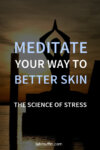
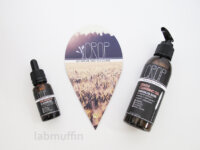
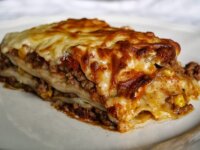
Thanks Michelle! This was super helpful – I like the 2% BHA too, and I think I’ll try the 0.3% retinol.
Do you have any thoughts about the 25% AHA + 2% BHA chemical peel, and the 8% AHA gel? Thanks 😊
I only ever tried the PC 2% Liquid exfoliant, and that was late last year, so I can’t say if you missed anything. I can say though (as I just wrapped up filming my review) that I adore it and could kick myself for waiting so long to try it…
One more question, sorry! If I want to introduce my first booster to my skincare regime, should I pick C15 or 10% niacinamide? I only want to do one at a time. I’m 40 with normal skin (slightly dry in winter) and I use retinol and 2% BHA on alternating nights. Thanks Michelle =)
Thank you Michelle!
I love their 2%BHA and their Azalaeic Acid Booster. Will try the niacinamide booster. I got breakouts from the ordinary one with Zinc.
Azalaeic Acid is a bit underrated. I highly recommend it for evening skin tone and acne scars or generally acne prone skin.
As for BHA I recently tried the Skinceuticals Age and Blemish which has a Salicylic Acid concentration of 1.5% and it’s been also really good for my skin. The price point is higher though I think. Have you tried it?
Great roundup, I’m a big fan of her products. I haven’t tried the niacinamide but will add it to my list. I love the azelaic acid- it’s the only thing that has calmed my rosacea.
Great post! I’m a big fan of PC products. It is a shame that the azaleic acid isn’t available in Australia anymore. Which azaleic acid product do you recommend instead?
Yeah it’s illegal to have azelaic acid in cosmetics since it’s a drug here – Finacea and Azclear are great! Finacea has a slightly nicer texture. You have to ask the pharmacist to grab it for you from behind the counter though!
Great review!
I have been using PC for many years and I attribute her products to finally getting rid of my adult acne – that I still had in my 60s. While that acne is controlled I remain with super oily skin. BTW, it’s a myth oily skin prevents wrinkles, especially if you have an expressive face. You just have oily skin with makeup products that migrate into them faster :-). I started using her products in my 50s and I’m 66. Some of the best out there!
The Resist SPF and Resist Daily BHA have never left my skincare rotation. Not having any success with OTC retinols, I recently tried the PC 1% since it was reformulated from the 1st time I tried it. No luck with the Vit C or niacinamide boosters. Glow Recipe is my go-to niacinamide. First time ever see diminished pore size.
I’m glad found your site. I’m over the fear-mongering that goes on in the skincare industry. I’ve been using PC 2% BHA for years ( my fave now is the Resist version) and it was a gamechanger. I like the Resist spf 50 as it works great on my aging, super oily, dehydrated skin. You might want to give it a go. I’ve tried the spf 30 you mention but it’s too light for me unfortunately. I’ve tried many PC products and I’ve found their prices have increased over the years. I’m always looking for deals because I’m on a budget. I’m thinking about trying the new phytoestrogen serum.
I’ve been on an Olay Regenerist routine for over 10 years and felt like it wasn’t working anymore as wrinkles and enlarged pores have made appearances more frequently. I saw all of these articles about Paula’s Choice and decided to try the 2% BHA. It’s only been a couple of weeks but started seeing results in only a few days. Absolutely amazing!
First, I really enjoy reading your material.
I do have a question – you mentioned you use (used) tretinoin. Do you still use it and are you using it with a hydroxy acid? I’m almost 3 months into my tret journey (prior to that, I was a PC loyalist and the 2% BHA was my jam, but now I’m afraid to even look at it. So, curious what you do now.